 Daily Scripture Reflections for Tuesday
Daily Scripture Reflections for Tuesday
Scripture: Lectionary 480. Ephesians 5:21-33. Psalm 128:1-2.3.4-5. Luke 13:18-21:
Luke has only these two parables which are among the Kingdom Parables. Matthew is the Evangelist who hands on the parable of the kingdom which came from Jesus. In reading them in Luke, it is best to consider the context in which they are found. We are well into the Journey Narrative of Luke (chapters nine and part of chapter nineteen). The Journey Narrative is all about discipleship and how to follow Jesus into the sacred paschal mysteries of life, death, and resurrection. The context is one of opposition to Jesus by the Samaritans, the rulers and lawyers, and probably some of the crowd.
Fr. Karris sums it up in this way: “These parables comfort disciples who, as they continue their master’s journey, will also face fierce opposition. They also show why Jesus’ kingdom mission was opposed.” The parables do emphasize the remarkable growth of good seed and of leaven in the baking of bread. In fact, the parables are similar to what rabbis also spoke in instructing their listeners. They said, “It is the case with the (kingdom) as with a grain of mustard seed.”
The process of imperceptible growth results in full surprise of the end-product—a healthy bush or small tree or a loaf of baked bread. Jesus showed in John’s Gospel the importance of both the seed surrendering to the earth, sun, and rain and the leaven allowing itself to permeate the dough. If not then it dies and does not produce. “I solemnly assure you, unless the grain of wheat falls to the earth and dies, it remains just a grain of wheat. But if it dies it produces much fruit.” (John 12:24).
The parable thus refers to the lesson of discipleship;it also is a lesson about the growth of the Church in Luke despite opposition. Finally, we personally are able to be instructed by its main point and see that we need to die to self-love in order to continue on the road of discipleship within the Church. The Johannine simile tells us what happens if there is no dying to self which is compared to a grain of wheat falling into the ground.
It is always helpful to remember we have three stages of thought behind the Gospels: first, the time of Jesus in which the parable was first said; then the preaching of the parable in the Gospel the apostles handed on, and finally the specific intention of the Evangelist who slants the message within his theological framework. Again, the rule of thumb is, text without context is pretext.
The same point is being made about wonder bread being made because of the leaven within the dough. At first, this is unseen, but then after the process of baking it is a delight for the palate and for nourishment. Even though leave is seen during the time of the Passover as something sinister and must be removed while only unleavened matzah or bread is served at the Passover meal. Jesus uses the “leaven” image in a positive way since is seen in the light of his teachings on discipleship and in the light of his own Passover Mysteries.
The parable reminded me of the description of the Eucharist in the Didache or the Teaching of the Twelve: “As this broken bread was scattered on the mountains, but brought together was made one, so gather your Church from the ends of the earth into your kingdom. For yours is the glory and the power through Jesus Christ forever. Amen.
Copyright 2012 Fr. Bertrand Buby, S.M.
About the Author

Guest
We welcome guest contributors who graciously volunteer their writing for our readers. Please support our guest writers by visiting their sites, purchasing their work, and leaving comments to thank them for sharing their gifts here on CatholicMom.com. To inquire about serving as a guest contributor, contact editor@CatholicMom.com.


.png?width=1806&height=731&name=CatholicMom_hcfm_logo1_pos_871c_2728c%20(002).png)
Comments